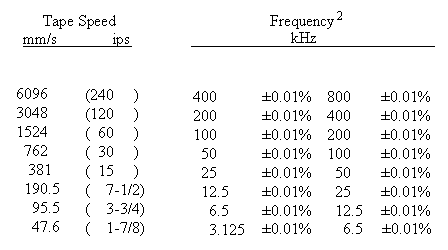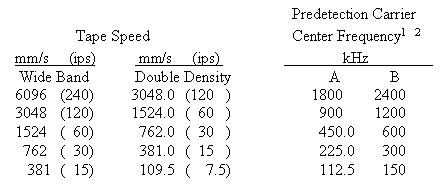|
IRIG 106-99 CHAPTER 6 - MAGNETIC TAPE RECORDER AND REPRODUCER STANDARDS, Continued.... 6.1 Introduction 6.2 Definitions 6.3 General Consideration for Longitudinal Recording 6.4 Recorded Tape Format 6.5 Head and Head Segment Mechanical Parameters 6.6 Head Polarity 6.7 Magnetic Tape and Reel Characteristics 6.8 Direct Record and Reproduce Systems 6.9 Timing, Predetection, and Tape Signature Recording 6.10 FM Record Systems 6.11 PCM Recording 6.12 Preamble Recording for Automatic or Manual Recorder Alignment 6.13 19-mm Digital Cassette Helical Scan Recording Standards 6.14 Multiplex/Demultiplex (MUX/DEMUX) Standard for Multiple Data Channel Recording on 19-MM Digital Cassette Helical Scan Recorder/Reproducer Systems 6.15 Submultiplex/Demultiplex Standards for Multiple Data Channels on a Primary Digital Multiplex/Demultiplex Channel 6.16 1/2 Inch Digital Cassette (S-VHS) Helical Scan Recording Standards 6.17 Multiplex/Demultiplex (MUX/DEMUX) Standards for Multiple Data Channel Recording on ½ Inch Digital Cassette (S-VHS) Helical Scan Recorder/Reproducer Systems MAGNETIC TAPE RECORDER AND REPRODUCER STANDARDS Continued.... 6.5 Head and Head Segment Mechanical Parameters 6.5.1 Gap Scatter 6.5.2 Head Segment Gap Azimuth Alignment 6.5.3 Head Tilt 6.5.4 Record-Head Segment Gap Parameters 6.5.4.1 Record-Head Segment Gap Length 6.5.4.2 Record-Head Stack Gap Azimuth Alignment 6.5.4.3 Reproduce-Head Segment Gap Azimuth Alignment The following subparagraphs describe the mechanical parameters of the head and head segments. 6.5.1 Gap Scatter. Gap scatter shall be 0.005 mm (0.0002 in.) or less for 25.4 mm (1 in.) tape (see figure 6-3 and subparagraph 4.1, appendix D). 6.5.2 Head Segment Gap Azimuth Alignment . The head segment gap azimuth shall be perpendicular to the head reference plane to within ±0.29 mrad (±1 minute of arc). 6.5.3 Head Tilt. The plane tangent to the front surface of the head at the center line of the head segment gaps shall be perpendicular to the head reference plane within ±0.29 mrad (±1 minute of arc) for wide band and double density recorders (see figure 6-3). 6.5.4 Record-Head Segment Gap Parameters . The parameters for the length and azimuth alignment are described in the following subparagraphs. 6.5.4.1 Record-Head Segment Gap Length . The record gap length (the perpendicular dimension from the leading edge to the trailing edge of the gap) shall be 2.16 6.5.4.2 Record-Head Stack Gap Azimuth Alignment . The record-head stack azimuth shall be perpendicular to the head reference surface to within ±0.29 mrad (±1 minute of arc). See paragraph 1.2, volume III, RCC document 118 for suggested test procedure. 6.5.4.3 Reproduce-Head Segment Gap Azimuth Alignment. The reproduce-head segment azimuth alignment shall match that of the record-head segment as indicated by reproducing an UBE frequency signal on a selected track and setting the reproduce head azimuth for the maximum output. At this azimuth setting, the output of any other track in the reproduce head shall be within 2 dB of the output at its own optimum azimuth setting (see paragraph 1.3, volume III, RCC document 118). 6.6 Head Polarity 6.6.1 Record-Head Segment 6.6.2 Reproduce-Head Segment See chapter 1, volume III, RCC document 118 and subparagraph 4.2, appendix D of this document for additional information. 6.6.1 Record-Head Segment. Each record-head winding shall be connected to its respective amplifier in such a manner that a positive going pulse referenced to system ground at the record amplifier input will result in the generation of a specific magnetic pattern on a segment of tape passing the record head in the normal direction of tape motion. The resulting magnetic pattern shall consist of a polarity sequence of south-north-north-south. 6.6.2 Reproduce-Head Segment . Each reproduce-head segment winding shall be connected to its respective amplifier in such a manner that an area of a tape track exhibiting a south-north-north-south magnetic pattern will produce a positive going pulse with respect to system ground at the output of the reproducer amplifier. 6.7 Magnetic Tape and Reel Characteristics 6.7.1 Tape Width 6.7.2 Tape Guiding Magnetic tape and reel characteristics are specified in chapter 7. It is recommended that all recorder and reproducer systems at a particular range be calibrated for operational use against a reference tape of the type used by the range for each bandwidth class of recorder and reproducer system. Additional supplementary procurement specifications may be required to meet a particular operational requirement of the ranges. 6.7.1 Tape Width. The standard nominal tape width is 25.4 mm (1 in.) (see table 7-1 , Tape Dimensions). 6.7.2 Tape Guiding. The tape guidance system restricts the tape angular motion to ±0.15 mrad (±30 seconds of arc) as measured by the interchannel time displacement error (ITDE) of outer tracks on the same head stack. Make sure the guidance system does not damage the tape. 6.8 Direct Record and Reproduce Systems 6.8.1 Direct Record Parameters 6.8.2 Standard Record Level 6.8.3 Reproduce Parameters 6.8.4 Tape Speed and Flutter Compensation Direct recording is a method of recording information signals on magnetic tape using high-frequency ac bias recording (see paragraph 6.2, Definitions). Two classes of systems, wide band and double density, are included in these standards (see table 6-1). 6.8.1 Direct Record Parameters. The following subparagraphs describe the direct record parameters. 6.8.1.1 The input impedance for wide band and double density recorders shall be 75 ohms nominal across the specified band. 6.8.1.2 Input gain adjustment shall be provided to permit sine-wave signals of 0.35 to 3.5 V rms to be adjusted to produce standard record level. 6.8.1.3 Ideally, the recorded flux level on tape versus frequency should be constant. To approach this ideal, the record amplifier transfer characteristic is basically a constant current versus frequency with a superimposed compensation characteristic to correct only for loss of recording efficiency with frequency. Results of the test described in paragraph 4.8, volume III, RCC document 118, with the output amplitude at the 2 percent upper band edge (UBE) frequency used as the 0 dB reference, shall be no greater than the following: 6.8.1.4 Record bias setting information is contained in table 6-1. The bias frequency shall be greater than 3.5 times the highest direct record frequency for which the recorder and reproducer system is designed (see appendix D ). 6.8.2 Standard Record Level. The standard record level for direct record systems is the input level of the record level set frequency, which produces an output signal containing 1 percent third harmonic distortion. The conditions necessary to establish the standard record level include appropriate selection of the sinusoidal reference frequency (record level set frequency) as indicated in table 6-1 and proper reproduce amplifier termination as defined in figure 4-2, volume III, RCC document 118. A 1 percent third harmonic distortion content is achieved when the level of the third harmonic of the record level set frequency is 40 dB ±1 below the level of a sinusoidal signal of 30 percent of UBE frequency which is recorded at the standard record level (see paragraph 5.0, appendix D for information regarding standard test and operating practices). 6.8.3 Reproduce Parameters. The following subparagraphs describe the reproduce parameters. 6.8.3.1 For wide band and double density recorders, the output impedance shall be 75 ohms nominal across the specified passband. 6.8.3.2 When reproducing a signal at the record level set frequency (recorded at the standard record level), the output level shall be a minimum of 1 V rms with a third harmonic distortion of 1 percent and a maximum second harmonic distortion of 0.5 percent when measured across a resistive load of 75 ohms. Lack of proper output termination will not cause the reproduce amplifier to oscillate. 6.8.4 Tape Speed and Flutter Compensation . The average or long-term tape speed must be the same during record and reproduce to avoid frequency offsets, which may result in erroneous data. To minimize this problem, a reference signal may be applied to the tape during record and the signal used to servo-control the tape speed upon reproduce. However, because servo-control systems have limited correction capabilities and to minimize the amount of equipment required at the ranges, tape speeds and servo-control signals shall conform to the following standards. 6.8.4.1 The effective tape speed throughout the reel or any portion of the reel (in absence of tape-derived servo-speed control) shall be within ±0.2 percent of the standard speed as measured by the procedures described in chapter 2, volume III, RCC document 118. 6.8.4.2 Sinusoidal or square wave speed-control signals are recorded on the tape for the purpose of servo-control of tape speed during playback. The operating level for speed-control signals shall be 10 dB ±5 below standard record level when mixed with other signals or standard record level when recorded on a separate track. 6.8.4.3 The constant-amplitude speed-control signal shall be used on a separate track for optimum servo-speed correction. The speed-control signal may be mixed with other signals if recording requirements so demand and system performance permits. Mixing of the speed-control signal with certain types of signals may degrade system performance for tapes which are to be reproduced on tape transports with low time-base error capstan drive systems (refer to manufacturer). Table 6-5 lists speed-control signal frequencies. The speed-control signal may also be used as a flutter correction signal. 6.8.4.4 Signals to be used for discriminator flutter correction systems are listed in tables 3-3 and 6-5. See subparagraph 6.8.4.3 and table 3-3 for restrictions on use of flutter correction signals. |
|
|
 |
|
1 May also serve as
discriminator flutter-correction reference signal (see
table 3-3). 2 Either set of speed-control signals may be used primarily with wide band systems, but only the higher set of frequencies is recommended for double density systems. When interchanging tapes, care should be taken to ensure that the recorded speed-control signal is compatible with the reproduce system's speed-control electronics. |
 Caution should be used when multiplexing other signals with the speed-control
signal. In the vicinity of the frequency of the speed-control signal (fsc ±10
percent), the level of individual extraneous signals including spurious, harmonics,
and noise must be 40 dB or more below the level of the speed-control signal. A
better procedure is to leave one octave on either side of the speed-control signal
free of other signals.
Caution should be used when multiplexing other signals with the speed-control
signal. In the vicinity of the frequency of the speed-control signal (fsc ±10
percent), the level of individual extraneous signals including spurious, harmonics,
and noise must be 40 dB or more below the level of the speed-control signal. A
better procedure is to leave one octave on either side of the speed-control signal
free of other signals.
|
|
|
 |
|
1 The predetection
record/playback passband is the carrier center frequency ±66.7 percent. 2 Use center frequencies in column B when data bandwidth exceeds the capabilities of those in column A. |
|
6.9 Timing, Predetection, and Tape Signature
Recording 6.9.1 Timing Signal Recording 6.9.2 Predetection Recording 6.9.3 Tape Signature Recording Described in the following subparagraphs are timing signal, predetection, and tape signature recording. 6.9.1 Timing Signal Recording . Modulated-carrier, time-code signals (IRIG A, IRIG B and IRIG G) are widely used and other formats are available. When recording IRIG B time-code signals, care must be taken to ensure that low-frequency response to 100 Hz is provided. The direct record, low frequency cutoff of most wide band recorders is 400 to 800 Hz. For these systems, IRIG B time code signals should be recorded on an FM track or on an FM subcarrier. The widest bandwidth subcarrier available should be employed to minimize time delay 1. For double density systems, all time code signals should be recorded on an FM track or an FM subcarrier. 6.9.2 Predetection Recording. Predetection signals have been translated in frequency but not demodulated. These signals will be recorded by direct (high frequency bias) recording. Parameters for these signals are in table 6-6. 6.9.3 Tape Signature Recording. For data processing using wide band and double-density recorders and reproducers, a tape signature recorded before or after the data, or both before and after the data, provides a method of adjusting the reproducer head azimuth and reproduce equalization. A means is also provided for verifying the proper operation of equipment such as playback receivers and bit synchronizers used to retrieve the recorded data. A pulse code modulation (PCM) signature is recommended where primarily PCM data is recorded. A swept-frequency or white-noise signature may be used for other data such as frequency division multiplexing (FDM) or wide band FM. The procedures for recording and using these signatures are given in paragraph 7.0, appendix D. A recommended preamble/postamble signal for recorder/reproducer alignment is included in paragraph 6.12. Footnotes 1. Timing code formats are found in IRIG standard 200-89, Time Code Formats and IRIG standard 205-87, Parallel Binary and Parallel Binary Coded Decimal Time Code Formats. |